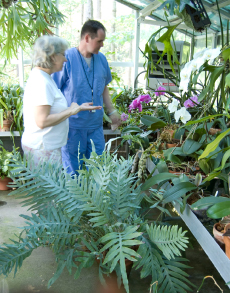Therapy in a tomato plant
 |
In his hospital scrubs in the late afternoon sun, Kirk Hines (right) bags a small orchid, telling a customer she’ll need to replant it in orchid mix when she gets home. To another, he offers a deal on a towering prickly cactus. “I was bleeding when I brought it out of the greenhouse, and I don’t want to take it back.”
Today Hines is a one-man salesman, cashier, and master gardener at the Wesley Woods Hospital plant sale. He is also a registered horticultural therapist (one of only two in Atlanta and only 270 in the country), who founded horticultural therapy services at the geriatric and chronic care hospital in 1993. The plant sale to Emory staff, held several times each year, raises money for soil and pots to help sustain the program.
Patients grow the plants in therapy sessions that improve fine motor skills, muscle tone, range of motion, strength, even peace of mind. Hines considers the greenhouse, today abloom with pink and white orchids, as another clinical space.
In fact, here and in two courtyard gardens, a walking garden, and indoor growing spaces, he works with older people who have lost their motor skills, need help with strength or balance, or enjoy the relaxation that gardening brings. For those who are unable to enjoy the outdoor spaces, he brings light carts and planting stations inside or works with individuals at the bedside.
“We want our patients to be successful,” says Hines. “Gardening draws on long-term memory for many of them. While they are planting tomato seeds or digging in the dirt, it takes away the anxiety they feel away from home. They don’t feel like they are in a hospital environment.”
The two courtyards are designed as healing gardens. There are handrails to prevent falls and provide support. The walkways use surfaces that prevent glare. Shady seating areas are scattered around the lush space for an older population that is particularly sensitive to temperature. Both courtyards have burbling fountains, one with large, brightly colored goldfish that swim around a bald cypress that Hines is growing to train—when the time is right—into a miniature bonsai.
In the walking garden around the greenhouse, surfaces covered with a variety of concrete, stone, and other natural pavers allow Hines to work with patients on gait training. Those trying to regain mobility can practice on surfaces that more resemble the ones they will encounter in real life rather than the polished floors of the traditional therapy unit. “We are able to get more out of patients in the garden setting,” says Hines. “They tend to work harder and longer.”
Of all the gardening spaces, the Wesley Woods Legacy Garden is a showpiece for sensory stimulation. A local artist designed an arbor complete with a swing and draped with evergreen clematis. Wild grasses sway in the breeze. Blueberries call to be tasted, fuzzy lamb’s ear to be touched. The garden, orderly but informal, extends naturally into the 64 acres of old growth, protected forest and wetlands that make up the campus.
These spaces, however, didn’t just spring up overnight or without effort. It has taken Hines—piecing together grants, donations, and volunteers—17 years to bring the areas into full bloom. A University of Georgia master’s student designed plans for the courtyard for dementia patients. Eagle scouts have built raised beds and composting units. The Southeastern Horticultural Society supported installation of the Legacy Garden. Local landscapers have pitched in with materials, and community volunteers have helped plant, water, and weed. One family so appreciated the care their grandmother received in the horticultural therapy program that it donated and planted 300 daffodils—pseudo narcissus to be exact—on the grounds in her honor.
Still, as beautiful as the gardens are, their purpose extends well beyond aesthetic enjoyment. “Everything here exists for the patients,” Hines says. “We prepare the materials for patients to use to get better. The garden helps them get in tune with the seasons and the cycle of life, from which they are so often removed in the hospital. It brings about orientation and contact with life. It is a small thing on the way to recovery.”
When patients are discharged, they usually take the favorite plants they have grown in horticultural therapy with them. When they come back to campus for outpatient visits, they sometimes see Hines in the halls, and they like to stop and talk. They want
to let him know how their plants are doing. —Rhonda Mullen
A green opportunity: Emory University Hospital is now planning a healing garden for the neuro ICU. For more information about that project or to make a gift, contact Ellen Sacchi, senior director of development for Emory Hospitals, esacchi@emory.edu, 404-712-4152. |
||


